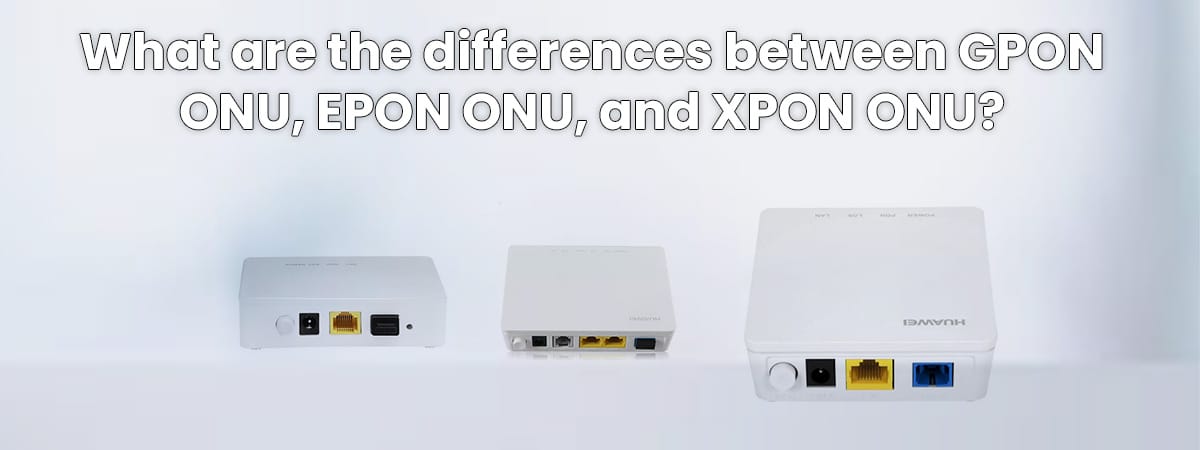Introduction
Optical Network Units (ONUs) are the endpoints of a point-to-multipoint access network, usually connected to a Passive Optical Network (PON). There are three common types of ONUs, namely GPON ONU, EPON ONU, and XPON ONU. Each type of ONU has its own advantages and disadvantages, and they are used in different scenarios. This article will discuss the differences between GPON ONU, EPON ONU, and XPON ONU in terms of their characteristics, applications, and limitations.
GPON ONU
GPON ONU is a type of ONU that uses Gigabit Passive Optical Networks (GPON) for point-to-multipoint access. GPON technology is based on the ITU-T G.984 standard and is capable of delivering data rates up to 2.488 Gbps downstream and 1.244 Gbps upstream. GPON ONUs are used in fiber-to-the-home (FTTH) and fiber-to-the-curb (FTTC) applications, providing high-speed broadband access services to residential, business, and enterprise customers. GPON ONUs are also used in enterprise LANs, providing high-speed access in data centers and office buildings.
Advantages of GPON ONU
GPON ONUs offer several advantages over other types of ONUs. They offer high-speed access with data rates up to 2.488 Gbps downstream and 1.244 Gbps upstream. Additionally, GPON ONUs are cost effective, as they use the existing fiber infrastructure and require minimal additional hardware. GPON ONUs are also more reliable than other types of ONUs, as they use a technique called dynamic bandwidth allocation, which ensures that bandwidth is allocated efficiently among multiple users.
Applications of GPON ONU
GPON ONU is used in FTTH and FTTC applications to provide high-speed broadband access services to residential, business, and enterprise customers. GPON ONUs are also used in enterprise LANs, providing high-speed access in data centers and office buildings.
Limitations of GPON ONU
Despite its advantages, GPON ONU has some limitations. The most notable limitation is its limited range, as GPON is designed to be deployed in short-distance applications. Additionally, GPON ONUs are relatively expensive compared to other types of ONUs, as they require additional hardware and installation costs.
EPON ONU
EPON ONU is a type of ONU that uses Ethernet Passive Optical Networks (EPON) for point-to-multipoint access. EPON technology is based on the ITU-T G.983 standard and is capable of delivering data rates up to 1 Gbps downstream and 1 Gbps upstream. EPON ONUs are used in FTTH and FTTC applications, providing high-speed broadband access services to residential, business, and enterprise customers.
Advantages of EPON ONU
EPON ONUs offer several advantages over other types of ONUs. They offer high-speed access with data rates up to 1 Gbps downstream and 1 Gbps upstream. Additionally, EPON ONUs are cost-effective, as they use the existing fiber infrastructure and require minimal additional hardware. EPON ONUs are also more reliable than other types of ONUs, as they use a technique called dynamic bandwidth allocation, which ensures that bandwidth is allocated efficiently among multiple users.
Applications of EPON ONU
EPON ONU is used in FTTH and FTTC applications to provide high-speed broadband access services to residential, business, and enterprise customers. EPON ONUs are also used in enterprise LANs, providing high-speed access in data centers and office buildings.
Limitations of EPON ONU
Despite its advantages, EPON ONU has some limitations. The most notable limitation is its limited range, as EPON is designed to be deployed in short-distance applications. Additionally, EPON ONUs are relatively expensive compared to other types of ONUs, as they require additional hardware and installation costs.
XPON ONU
XPON ONU is a type of ONU that uses 10-Gigabit-capable Passive Optical Networks (XPON) for point-to-multipoint access. XPON technology is based on the ITU-T G.987 standard and is capable of delivering data rates up to 10 Gbps downstream and 2.5 Gbps upstream. XPON ONUs are used in FTTH and FTTC applications, providing high-speed broadband access services to residential, business, and enterprise customers.
Advantages of XPON ONU
XPON ONUs offer several advantages over other types of ONUs. They offer high-speed access with data rates up to 10 Gbps downstream and 2.5 Gbps upstream. Additionally, XPON ONUs are cost-effective, as they use the existing fiber infrastructure and require minimal additional hardware. XPON ONUs are also more reliable than other types of ONUs, as they use a technique called dynamic bandwidth allocation, which ensures that bandwidth is allocated efficiently among multiple users.
Applications of XPON ONU
XPON ONU is used in FTTH and FTTC applications to provide high-speed broadband access services to residential, business, and enterprise customers. XPON ONUs are also used in enterprise LANs, providing high-speed access in data centers and office buildings.
Limitations of XPON ONU
Despite its advantages, XPON ONU has some limitations. The most notable limitation is its limited range, as XPON is designed to be deployed in short-distance applications. Additionally, XPON ONUs are relatively expensive compared to other types of ONUs, as they require additional hardware and installation costs.
Conclusion
To sum up, GPON ONU, EPON ONU, and XPON ONU are three types of ONUs used for point-to-multipoint access. Each type of ONU has its own advantages and disadvantages, and they are used in different scenarios. GPON ONU is used in FTTH and FTTC applications, EPON ONU is used in FTTH and FTTC applications, and XPON ONU is used in FTTH and FTTC applications. Each type of ONU has its own advantages and disadvantages, and they should be chosen based on the application requirements.
